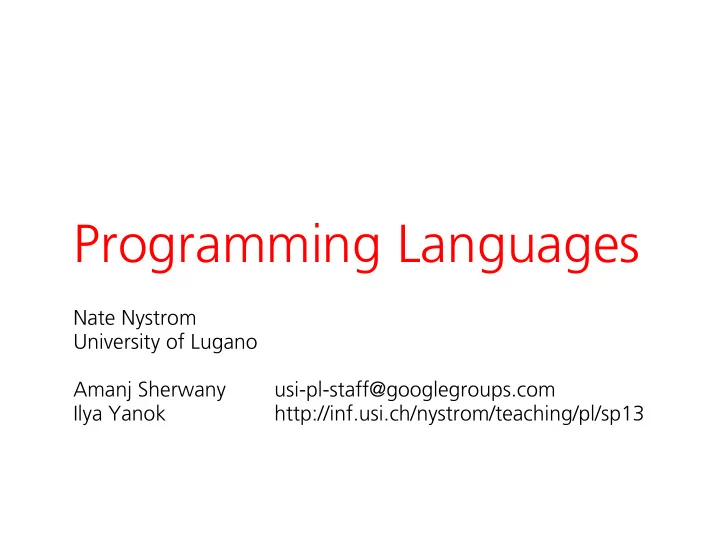

Programming Languages Nate Nystrom University of Lugano Amanj Sherwany usi-pl-staff@googlegroups.com Ilya Yanok http://inf.usi.ch/nystrom/teaching/pl/sp13
Who are we? Nate Nystrom Amanj Sherwany Ilya Yanok 2
1991–1995 Purdue: BS Computer Science, Mathematics About me 1996–1998 Purdue: MS Computer Science 1998–1999 Hewlett-Packard: compiler engineer 1999–2006 Cornell: PhD Computer Science 2006–2009 IBM Research PL/SE group 2009–2010 Arlington, Texas: Assistant Professor 2011–present University of Lugano: Assistant Professor 3
My research Using programming languages to solve systems problems: Extensibility • Polyglot, an extensible compiler framework • http://www.cs.cornell.edu/Projects/polyglot • A framework for Scala compiler plugins Concurrency and distribution and fault tolerance • X10, a concurrent OO language for HPC • http://www.x10-lang.org • Firepile, a Scala library for GPU programming • Languages for reasoning about relaxed consistency 4
Book / scribing Types and Programming Languages By Benjamin C. Pierce I will not follow the book very closely Most lectures will not use slides Each lecture, one of you will be a scribe and take notes for the class. (This does not mean you shouldn’t take your own notes.) We will post the scribe notes on the web page. You should edit your notes for clarity and accuracy. Send the staff your notes within a week of the lecture so we can post them. 5
Grading Assignments 40% Midterm exam 25% Final exam 25% Scribing and participation 10% 6
Assignments Some writing. Some math. Some programming, but not too much About one homework every 7-10 days Plus occasionally some small exercises due before the next lecture, usually one or two short questions 7
Website http://inf.usi.ch/faculty/nystrom/teaching/pl/sp13/ Everything will be posted there 8
Moodle Exists. 9
How would you like us to communicate with you?
Community Moodle forums are an abomination unto Nuggan. Join the G+ community for this course. • Discuss assignments, ask questions there. • Announcements will go there and to the web page. Questions for the staff: usi-pl-staff@googlegroups.com 11
What do you want to get out of this course?
What do I want you to get out of this course?
What do I want you to get out of this course? • Become familiar with different programming paradigms • Understand principles behind programming languages • Apply these principles to solve “real” problems 14
What do I want you to get out of this course? • Become familiar with different programming paradigms • Understand principles behind programming languages • Apply these principles to solve “real” problems 15
Language features We’ll look at features common across multiple languages Variables Functions Eager and lazy evaluation Mutable state (assignment) Exotic control-flow constructs: exceptions, continuations Typing, subtyping, polymorphism Objects 16
Different paradigms We’ll look at several different programming languages and try to distill them to their essential features We’ll also look at how those features interact • e.g., parametric polymorphism + subtyping = WTF!? But, we’ll program primarily in Haskell 17
Why Haskell?
Get out of your comfort zone 19
Learning zone 20
Panic zone 21
Why Haskell? Haskell is a pure functional language • No assignment, no loops • You have to think differently about programs Haskell is lazy • Think about computation as function composition, not as a sequence of instructions 22
Haskell crash course This Thursday Bring your computers 23
What do I want you to get out of this course? • Become familiar with different programming paradigms • Understand principles behind programming languages • Apply these principles to solve “real” problems 24
PL principles Focus is on semantics (what do programs mean?) (Mostly) ignore syntax (what do programs look like?) 25
Dynamic semantics How does a program behave? How is a program evaluated? We’ll experiment with different semantics by implementing interpreters We’ll define behavior formally with operational semantics Formal semantics lets you state precisely and prove properties of programs 26
What does this expression do? ‘1’ + ‘2’ 27
Static semantics Restrictions on programs to provide (some) correctness guarantees • e.g., if this program type checks, it won’t core dump Focus on type systems Some other formal methods (e.g., program verification) are covered in other classes 28
What do I want you to get out of this course? • Become familiar with different programming paradigms • Understand principles behind programming languages • Apply these principles to solve “real” problems 29
Languages are models of dynamic systems A programming language provides abstractions and ways to compose these abstractions The languages you are familiar with are models of computer systems They provide abstractions for data and computation 30
abstractions compositions addresses, registers, Assembly languages sequences of instructions instructions, labels booleans, arithmetic, loops, sequences of statements, Procedural languages arrays, procedures procedure calls objects, methods, fields, method invocation, OO languages classes inheritance first-class functions, function application, type Functional languages algebraic data types constructors 31
Languages are models of dynamic systems But languages can model not just computer systems, but any dynamic system General-purpose languages provide abstractions for modeling computation Domain-specific languages provide abstractions for other domains 32
Domain-specific languages abstractions compositions SQL relations, tuples, queries joins, selection, projection make files, build rules dependencies sequences, alternation (|), lex characters, strings repetition (*) tokens, nonterminal yacc grammar rules symbols packets, network flows, matching, actions (drop, OpenFlow channels forward, etc) union, intersection, linear OpenSCAD shapes transformations 33
Domain-specific languages When designing a system, can be useful to think of the system as a language Implement the system as an interpreter for a domain-specific language A DSL can either: • be a language in its own right or • e.g., yacc • be embedded in a general-purpose language as a library • e.g., parser combinators Same issues that arise with general-purpose languages arise with domain-specific languages • name binding, control-flow, mutation, evaluation order, ... • similar problems => similar solutions 34
Homework for Thursday Do Assignment 0. It’s easy. • https://docs.google.com/forms/d/1Mers7bsiRrG6_VF9YcYkIEM-AIiIjAtoz90cWHWSt40/viewform Install ghc (the Glasgow Haskell Compiler) • 7.4 or later • http://haskell.org • Mac users: • brew install ghc haskell-platform • port install ghc 35
Recommend
More recommend